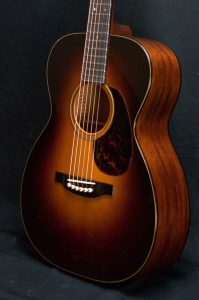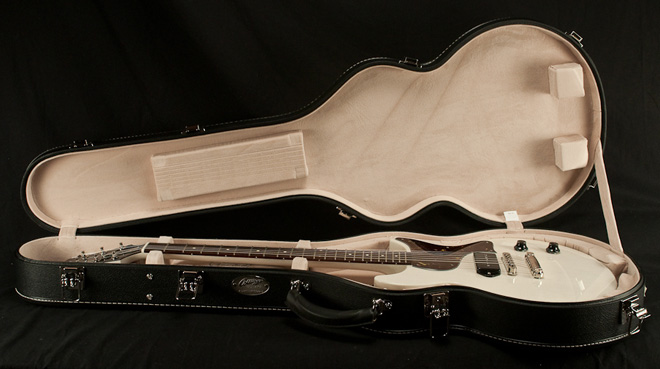How do I love thee, mahogany? Let me count the ways: L‑00, D‑18, O‑22, J‑45, Les Paul Junior….
Mahogany is the cornerstone tonewood of the fretted instrument world. What it lacks in dramatic visual appeal and breathless testimonial from wood-sniffers, it more than makes up for in suitability for instrument construction. If aliens landed tomorrow and announced they were taking all the tonewoods back to their home planet, but were willing to leave us one species to carry on building with, what else could we cling to that would be usable for making virtually every part of a guitar? Maple might make a better fingerboard, but mahogany is one of the only hardwoods that makes a decent top wood, in addition to being ideal for necks, blocks, kerfed linings – just about every part of the guitar.
Where it really shines, though, is when it is used for the back and sides of a steel-string acoustic guitar. Less dense than the rosewood species, its medium weight and open grain produce both warmth and punch, de-emphasizing the bass register while accentuating the crucial midrange, which, after all, is the guitar’s home turf in the tonal spectrum. I have always been attracted to the woody, open sound of a mahogany guitar, and, until the recent acquisition of a rosewood McPherson, have largely owned and played only mahogany guitars. For the player who values a dry, crunchy, punchy sound, mahogany gets the nod over rosewood’s rum-jug bass and metallic overtones.
From a builder’s perspective, mahogany is a dream to work with. Sharp chisels glide through with a crispy, satisfying crunch, a harbinger of the clear tones the finished instrument will produce. Hardly any task in lutherie is as satisfying to me as carving a mahogany neck, watching the drawknife go exactly where I send it with nary a bump, the polar opposite of curly maple’s swervy, fickle grain. The long, straight grain of the best mahogany makes a neck that will stay straight for generations; the same qualities make it an absolute joy on the bending iron when destined for a back-and-sides set. But what exactly is meant by the “best mahogany”? Isn’t all mahogany the same?
For such a simple wood, mahogany presents one of the most confusing classification systems in the timber world. On the face of it, would you think there would be a difference between “genuine mahogany” and “true mahogany”? But in those two similar words, genuine and true, lies a world of difference.
Capital “M” mahogany, the sought-after wood for guitar building, comes only from the three species of the genus Swietenia, tropical trees that, when converted to timber, are collectively referred to as “genuine mahogany.” Honduran mahogany (Swietenia macrophylla) is the species most often seen in the guitar-building world, with the rare Cuban mahogany (Swietenia mahagoni) and smaller Pacific Coast mahogany (Swietenia humilis) rounding out the genus. As Swietenia humilis is generally too small to produce good guitar lumber and Swietenia mahagoni is in extremely short supply, most of the mahogany seen in modern guitar construction is Swietenia macrophylla. It is the genuine mahogany… but is it true?
“True mahogany” is a term used to refer to species that are not, well, true mahogany, if you like consistent word usage. Suspending that for the moment, let’s reserve “genuine” for our three Swietenia species and examine what’s left.
Swietenia is one genus in a family of trees, the chinaberry or Meliaceae family, which grows all over the tropics. Aside from Swietenia there are several genera in the Meliaceae which produce timber suitable for musical instrument construction, among other uses. These are collectively referred to as “True Mahogany.” Species commonly seen in the guitar world include khaya, sipo, and sapele (and I will spare you further latin), all of which can make beautiful, toneful instruments. Still, caveat emptor (oops) – “true” does not mean “genuine.”
As a cautionary note, many other wood species that get called mahogany are nothing of the sort. There are many timbers which bear a superficial resemblance to mahogany but are from unrelated or distantly related species. Many of these travel under the handle “Philippine mahogany,” a non-specific term for several species of mahogany-like woods that are frequently seen in student-level guitars from overseas. None possesses the sterling qualities of the better species of mahogany, whether true or genuine.
Whew! Out of the weeds at last. To sum up, mahogany is one of the most useful and toneful woods in the luthier’s arsenal. To those who see mahogany as only good enough for lower-level instruments (and I suppose we have Mr. Martin to thank for that), I would send you to your record collection to see how many of the classic tones we have long enjoyed were produced by mahogany instruments. From Robert Johnson’s L-1 and KG-14, to Woody Guthrie’s SJ, Bob Dylan’s 00-17 (mahogany top, no less), John and George’s J-160E pair, Bob Marley’s Les Paul Special, Norman Blake’s D-18… need I go on? Mahogany guitars have long been recognized by the world’s greatest guitarists as making some of the finest sounds around. Time to stop thinking of tonewood as a hierarchy and check out some fantastic mahogany guitars!
Read more about tonewoods here.

Rob Sharer
Sound Pure Luthier
Rob is a multi-instrumentalist with decades of building and repairing under his belt, including extensive experience restoring vintage guitars.



